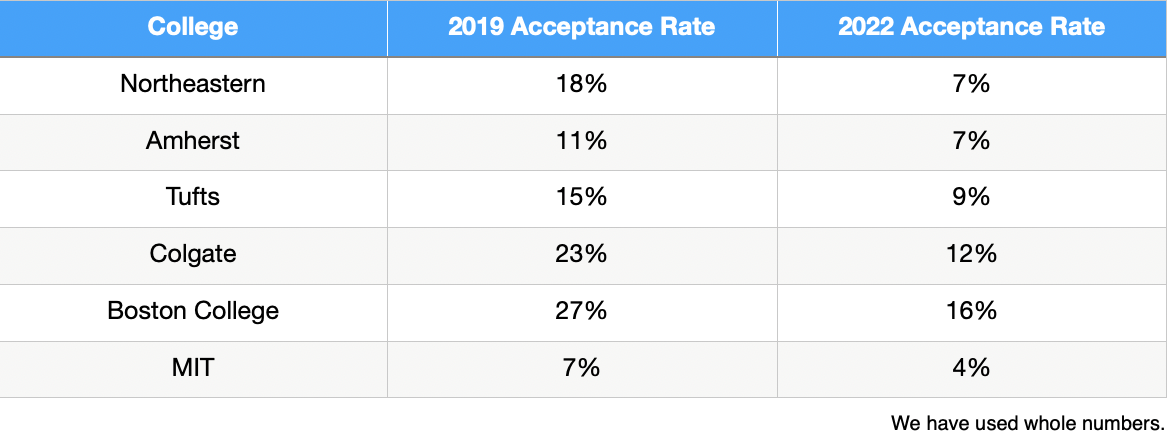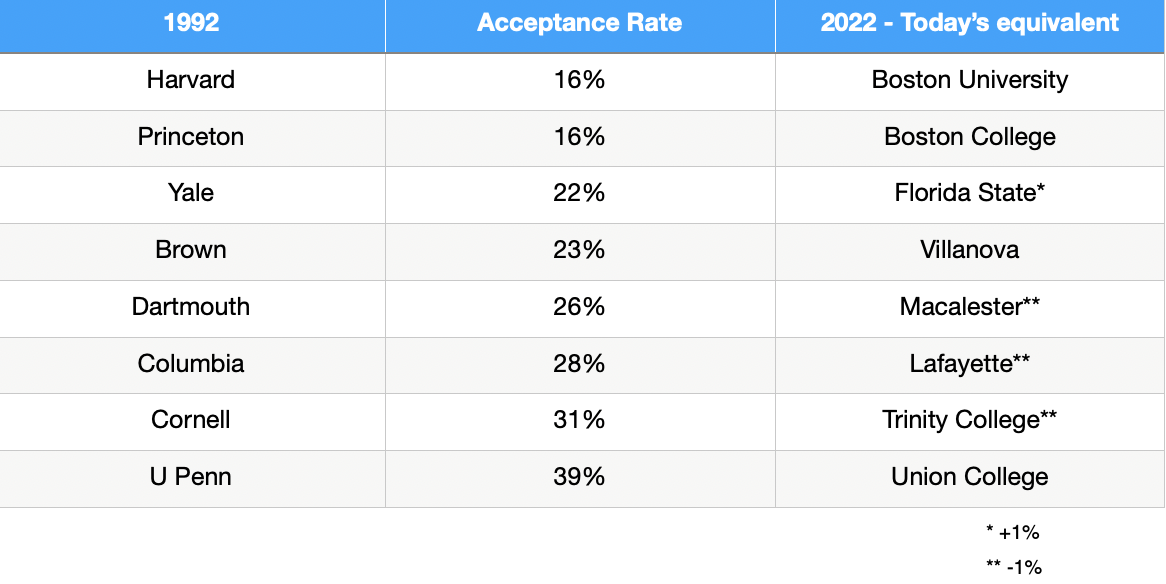Dream Crusher
This has been a rough few weeks. I have had many difficult conversations with students, parents, and families. I feel like my new name should be “dream crusher.” I am not trying to be funny because it is not funny. The current college admissions landscape for selective colleges is very, very tough. For many years running, admit rates have gone way down. In the last two years, they have gone down even more significantly.
One of my colleagues, Kate Sonnenberg, gave some succinct examples in her recent blog post; in fact, the admit rate is so low that some colleges, among them Princeton and Stanford, have decided not to disclose the number. Three universities – Harvard, Columbia and Massachusetts Institute of Technology (MIT)- had admit rates under 4%. Sixteen colleges and universities had admit rates under 10%. Just as notable, some universities saw significant drops in their admit rate from only one year earlier – New York University, for example, went from a 21% acceptance rate in 2021 to a 12.2% admit rate in 2022.
For many reasons we have covered in a past blog, applications to many colleges have significantly increased in the last two years, causing acceptance rates to drop dramatically. We focus on the highly selective colleges because what happens at these colleges trickles down to affect all colleges. We used the year 2019 to start because the pandemic already caused a skew in the numbers for 2020. This is just a small sampling of colleges.
Many of the parents I speak to went to highly selective colleges themselves. They see their kids have straight As and assume they can also attend highly selective colleges. The landscape is so different from what it was a few years ago. Another colleague Bari Norman held a virtual presentation this week in which she brilliantly compared admissions rates at all 8 of the Ivy Leagues in 1992 to today’s admissions rates and the equivalent colleges.
Kids have worked super hard for over three years now. When they hear how difficult it is to get into many highly selective colleges, they can often feel like, what was it all for? I promise each and every one of these students it is because you are going to go to a GREAT college. It might not be the one you first thought of, but if you do your “homework,” it will be a GREAT COLLEGE FOR YOU. Finding the right college is about finding the colleges that fit; a college the student can be proud to attend, and that parents would be happy to invest in, and moreover, one where the student can be successful. So why do I feel like I am constantly crushing dreams? I am trying to get students to stop focusing on prestige or only colleges they have heard of so they can start focusing on THEIR colleges. Sadly these days, this is a time-sensitive issue like never before. There is WAY more pressure on students to apply early. If a student spends too much time focused on a college that might not ever happen, they might miss the opportunity to get into their perfect match.
So how does one do that? It is summer, and the entire world is having a heat wave. The last thing rising seniors want to be doing is researching colleges, writing essays, or even worse, studying to take the ACT or SAT again.
Let’s pull that apart a bit. Researching colleges is not as much fun as it should be. One of the pandemic's silver linings is that colleges now have lots of virtual tours and information sessions. One of the worst things about the pandemic is that now most colleges offer great ways to explore them virtually. Let’s face it, seeing a college in person is way more entertaining. Students often get to explore a new city or town, eat at a favorite college student hang-out spot, and meet people. Parents get real quality time with their kids. Now that virtual options are so good and admit rates so low, many families are waiting to visit many of the colleges on their list until they know if their child has been accepted. This right of passage of traditional college visits is not as prevalent as it used to be. While it is great that people have saved money by avoiding these trips, it has changed the experience and not necessarily for the better. So while you can find many ways to research colleges virtually in our past blogs here, I encourage you to get out and do some live visits with your family. Look for open houses and days where you might be able to see more of the current students. Maybe set some time aside in August, when college students have returned to campus, but you have not started school yet.
Next, let’s discuss the dreaded application writing and essays. This is just plain hard. It is not too much fun. The only consolation I can provide is that I promise you it is better to get as much of this work done this summer as possible. Senior fall is the busiest time students will ever have in high school. They are probably taking the most challenging classes they have ever taken, have leadership roles in their activities, might also be interviewing at various colleges, and some are still preparing for and taking standardized tests. It is all truly too much, but thankfully it goes by quickly.
This brings me to my next grouchy point—the dreaded SAT and ACT. In my opinion, for many students, the new landscape of test-optional has not made things easier on students it has made it way more confusing. Many students have not put in the same effort they might have to prepare for these tests because they figure, hey, most colleges are test-optional, and I can just not submit my score if it is not what I want it to be. They are correct, but what they don’t realize is that at many colleges, they will have a higher percentage chance of acceptance with a good test score. The next thing is that the test range scores for most colleges have gone way up in the last two years. This means that there is WAY more pressure on test scores in many ways than ever before. Please read this very comprehensive report by Compass Prep for details and graphs confirming this.
Grade inflation in this country has been very real, especially during the pandemic. I can quote many articles I put at the bottom of this blog post, but here are just two points. First, from Compass Prep, The College Board reported that over 60% of college applicants in the class of 2021 obtained a 4.0 or better. Teachers may have awarded higher grades to compensate for instructional challenges during the pandemic. Second, from ACT’s blog A new report from ACT, the nonprofit organization that administers the ACT college readiness exam, finds evidence of grade inflation in high school seniors’ GPAs between 2010 and 2021. The average high school GPA increased 0.19 grade points, from 3.17 in 2010 to 3.36 in 2021, with the greatest grade inflation occurring between 2018 and 2021.
The fact that so many more students have high GPAs puts more and more pressure on colleges to try and quantify what each student’s GPA really means. How will they do that? They will look at a school’s profile to try and determine where students rank in their class. Maybe not an exact spot, but is this student top 5%, 10%, or 50%? They will try and understand what kind of course rigor the student has taken. They will look at that in the context of what a high school offers. One of the ways they might want to quantify this will be to look at how many AP classes a student has or has not taken. If they have taken APs, seeing a student's test scores also gives a college context and a way to compare you to others. Suppose you have all excellent AP scores, yay for you. Most students do not. So that begs the conversation, what to disclose and what not to? This gets complicated and will be left for another time. I bring up AP scores because if you don’t have great ones, it might put pressure on you to quantify your GPA with good ACT or SAT scores.
So back to me, I don’t want to be a dream crusher. I want to help students find their dream colleges. I am amazed every day by the brilliance and spirit of the students I am lucky enough to work with. They are truly incredible, and I want all of them and you too to realize that there is an incredible depth and breadth of fantastic institutions out there. Please get to work finding yours.
Links to articles on Grade Inflation:


